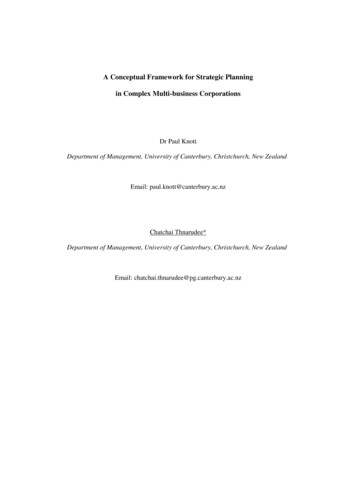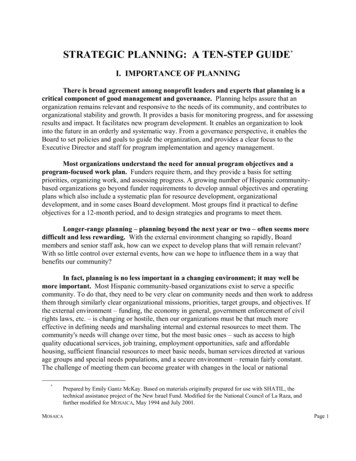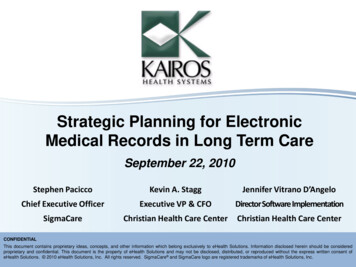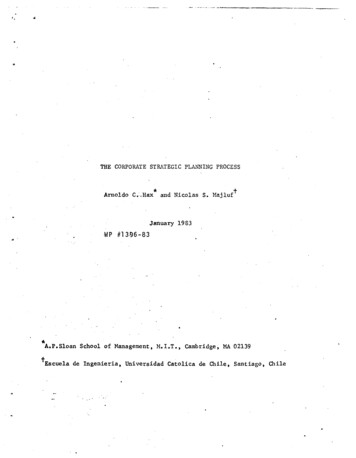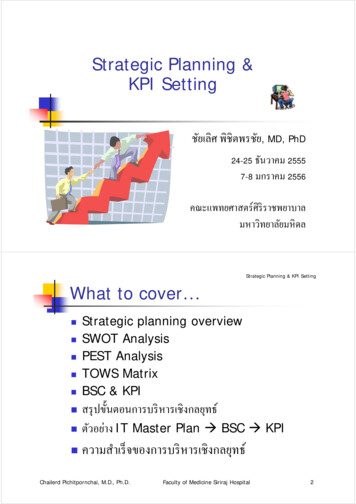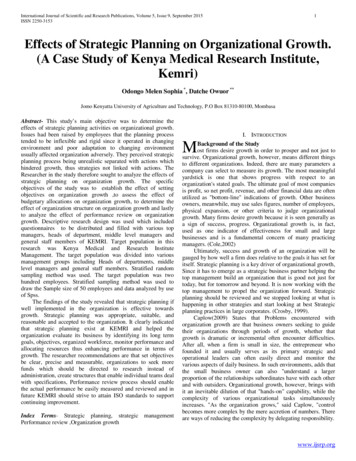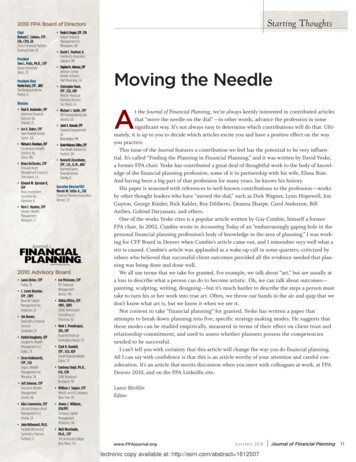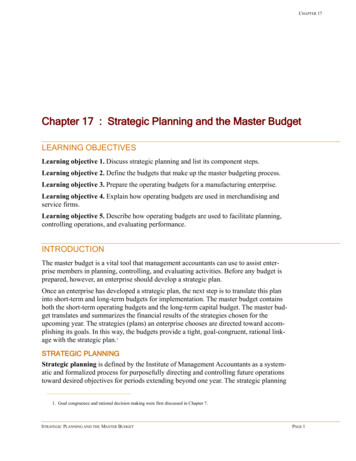
Transcription
CHAPTER 17Chapter 17 : Strategic Planning and the Master BudgetLEARNING OBJECTIVESLearning objective 1. Discuss strategic planning and list its component steps.Learning objective 2. Define the budgets that make up the master budgeting process.Learning objective 3. Prepare the operating budgets for a manufacturing enterprise.Learning objective 4. Explain how operating budgets are used in merchandising andservice firms.Learning objective 5. Describe how operating budgets are used to facilitate planning,controlling operations, and evaluating performance.INTRODUCTIONThe master budget is a vital tool that management accountants can use to assist enterprise members in planning, controlling, and evaluating activities. Before any budget isprepared, however, an enterprise should develop a strategic plan.Once an enterprise has developed a strategic plan, the next step is to translate this planinto short-term and long-term budgets for implementation. The master budget containsboth the short-term operating budgets and the long-term capital budget. The master budget translates and summarizes the financial results of the strategies chosen for theupcoming year. The strategies (plans) an enterprise chooses are directed toward accomplishing its goals. In this way, the budgets provide a tight, goal-congruent, rational linkage with the strategic plan.1STRATEGIC PLANNINGStrategic planning is defined by the Institute of Management Accountants as a systematic and formalized process for purposefully directing and controlling future operationstoward desired objectives for periods extending beyond one year. The strategic planning1. Goal congruence and rational decision making were first discussed in Chapter 7.STRATEGIC PLANNING AND THE MASTER BUDGETPAGE 1
process begins with a mission statement (see p. 782), which sets out the enterprise's purposes. These should include both the business purposes and the social (responsibility)purposes to employees, the community, and the environment. Bently Nevada Corporation's mission statement is the first of six steps in the strategic planning process, shownin Exhibit 17-1.Exhibit 17-1 Steps in the Strategic Planning ProcessStep 1Step 2Step 3Step 4Step 5Step 6Define the enterprise’s mission and prepare a formal mission statementEstablish objectives that, if achieved, should accomplish the mission.Define operating goals for the master budget period.Analyze the external and internal environmentDetermine strategies (actions) to capitalize on external opportunities and internal strengths and to overcome external threats and internal weaknesses.Measure results against the strategies planned.DEFINING OBJECTIVES AND GOALSObjectives are long-run statements of what the enterprise wants to accomplish. Theyserve as criteria for assessing long-run effectiveness. Objectives should be linked to themission, so that if they are realized, organizational survival should result. Goals are measurable translations of objectives. They are bound by a time period, usually the masterbudget time frame (the budget horizon). Progress toward goal achievement is measuredby the management accounting system and other information systems (manufacturingand marketing LANs, for example)2. Objectives and goals are often found in the Management Letter included in annual statements and in the Articles of Incorporation.Among the objectives IMAX (see p. 783) includes in its mission statement are the following:INSIGHTS & APPLICATIONSStrategic PrioritiesIn day-to-day business activities, as well as in long-term planning, strategic decisions must be made. It is vital that a framework for decision making be established that accurately reflectscorporate priorities and promotes consistency. At BentlyNevada we have the following priorities: Safety We continuously strive to create a safer workplace for our employees and toproduce products that function at peak performance and safetylevels. We will only design and market systems that reliably andeffectively monitor the behavior of your machinery. Safety alsoapplies to the environment. Bently Nevada is concerned aboutecology and is taking every step possible to ensure protection ofthe environment.Quality We define quality as “conformance to customer requiremenu.” Second only to safety, our highest priority is to consistently provide high quality products and services. Above all, wehave a deep commitment to continually improve the way weassist our customers. We've worked hard over the past 35 yearsto achieve our reputation as the top vendor in our industry andwe are proud of it! Timeliness Fast, reliable deliveries andprompt replies to inquiries are essential to our mutual success.Although timeliness is of the utmost importance, we will neverjeopardize safety or quality to meet deadlines. Cost We will continue to provide products of increasingly better value throughimproved technology and better manufacturing methods. Thisprocess of continuous improvement allows us to pass along savings to you. Our commitment to you is to provide the best valuein the industry. Courtesy of Bently Nevada Corporation Create a world-class manufacturing environment Obtain a 10 percent market share in the next five yearsFor the upcoming year, IMAX has established four goals:2. Different management and organizational design texts define goals and objectives differently. Semantics are notimportant here. What is important is the concept of rationally linking the mission statement through goals and objectivesto the operational plans for the budget horizon. An excellent discussion can be found in Chapter 2 of J. L. Gibson, J. M.Ivancevich, and J. H. Donnelly, Jr., Organizations: Behavior, Structure and Processes, 6th ed. (Dallas, Tex.: BPI, 1988).Page 2COST AND MANAGEMENT ACCOUNTING
CHAPTER 17 To provide customer service and flexibility, IMAX has a three-day cycle time policy for custom configurations and a two-day shipping time policy on standard configurations. To maintain high quality and low inventories of materials, IMAX is developing relationships with a fewhigh-quality suppliers. To promote a team concept, cross-training programs, just-in-time (JIT) cells, and quality circles havebeen made integral parts of the management plan. To work toward its 10 percent market share objective, IMAX has set a sales goal of 3,200 HighstepperPentiums for the upcoming year.CONSIDERING EXTERNAL AND INTERNAL CRITICAL FACTORSStrategic planning attempts to develop a combination of strategies to maximize theenterprise's performance while considering all critical factors, both external and internal.External critical factors include the following: Customers Vendors Shareholders Government Competitors Product or service life cyclesInternal critical factors include the following: Employees Activity-based management (ABM)INSIGHTS & APPLICATIONSIMAX Computers and the Highstepper Pentium“'Managing a new venture is often a greater challenge than managing an established business. To meet this challenge, it is critical thatthe start-up company implement a comprehensive budgeting process.IMAX Computers, a small start-up company, offers a new line ofpersonal computers known as Highstepper. Competition in the PCindustry is intense, and the technology can change rapidly. Flexibility, quality, and customer service are key success criteria. IMAXmanagement believes their market niche is in the west coastalUnited States. In the short run, to establish itself, IMAX is concentrating its marketing efforts in this region. In the long run, nationaland international sales will be important for growth. Consequently,the Highstepper is advertised in national trade publications and attrade conventions. Total quality management (TQM) Logistics Target costing, new product development, and life cycle analysis Throughput analysis Constraint optimizationThese, and other, critical environmental factors can be organized into the organization'sinternal strengths and weaknesses, and its external opportunities and threats (SWOT).SWOT takes into account the interactions between the organization and its environmentwith respect to what the organization does or plans to do (its objectives and goals). Management should understand; What the organization can do well What it cannot do very well Where it is vulnerable What countermeasures are appropriate against these vulnerabilitiesSTRATEGIC PLANNING AND THE MASTER BUDGETPAGE 3
Where the opportunities are How to take advantage of those opportunitiesBy using SWOT as a guidepost, alternate courses of action can be evaluated to determinehow well the enterprise overcomes its weaknesses and threats, and capitalizes on itsstrengths and opportunities in attempting to achieve its goals and objectives.The internal environment revolves around the corporate culture. Culture is composed ofgenerally accepted rules of behavior passed from generation to generation of employees.Five basic elements influence corporate culture: The internal environment created by management Its values Its heroes Rites and rituals (regular social activities) The informal communication (cultural) networkThe external environment can be characterized in six dimensions: The firm's competition Its legal and political environment Economic conditions External social and cultural values and customs Technological environment within the industry International business and cultural environments3INSIGHTS & APPLICATIONSMonsanto's Introduction of Cycle-SafeMonsanto's efforts to introduce Cycle-Safe illustrate the impactof a firm's external environment and the difficulty in predictingmanagement's future environment.Although Monsanto went to great lengths to ensure the safety ofCycle-Safe and received a favorable response to the new product,management did not anticipate the FDA ban. Two dimensions ofthe external environment—legal and social-cultural—impactedon Monsanto. The company believed that the FDA ban waslargely the result of the intense environmental concerns that permeated society at the time. Monsanto took a proactive stance tothe FDA ban of Cycle-Safe. First it initiated legal action. [then]Monsanto refiled Cycle-Safe with the FDA and finally receivedits approval.Analyzing and predicting the external environment, even in the short run of the masterbudget horizon, can be at best risky and at worst uncertain:4IMAX, in considering its sales goal and its goals for the world-class manufacturingobjective, identified a number of external opportunities and threats: Many customer orders are for standard configurations. Therefore, many High-stepper Pentiums can bemanufactured in a continuous (process) flow. While this can smooth production operations, a three-dayfinished goods inventory will have to be maintained because of the inherent variability in sales andbecause IMAX, as a start-up company, is unable to forecast short-term demand accurately. Although a few high-quality suppliers are available in the Silicon Valley area of northern California,establishing frequent deliveries (i.e., daily) for a JIT supply situation is not likely in the short run. A 10day lead time is required for PC boards. IMAX chose to locate in Reno, Nevada, because of the area's distribution channels to the primary WestCoast market and its low business and property taxes. Also, IMAX management feels it can establish agood relationship with the local government, and obtain favorable tax status by building a factory there.3. L. E. Boone and D. L. Kurtz, Management, 3d ed. (New York: Random House, 1987), pp. 52-54, We thank ProfessorTom Wright of the Managerial Sciences Department at the University of Nevada for these references and his insights.4. An uncertain environment is one in which the possible outcomes are not known. A risky environment has known outcomes to which probabilities of happening can be attached. Forecasting in risky environments can benefit from the use ofexpected value and probability statistical analyses.Page 4COST AND MANAGEMENT ACCOUNTING
CHAPTER 17 Through the local banking community and the Small Business Development Center at the University ofNevada, Reno, IMAX can apply for an SBA loan and develop long-run relationships for creating an EDIsystem. The new national government appears ready to support a proposed amendment to the Americans withDisabilities Act that will provide funding for small businesses with active policies for employing thehandicapped.IMAX management also has identified certain internal strengths and weaknesses thatcan impact its goal achievement: Production and administration facilities can be designed to facilitate efficient operations by handicappedemployees. Many of the production processes are amenable to wheelchair-bound employees. SinceIMAX is a new company, the plant and administration facilities can be designed for easy access andtravel by handicapped employees. For example, fairly cheap land allows for single-story construction.When purchasing office equipment, two-drawer file cabinets (instead of four-drawer) should be selectedto allow easy access by handicapped personnel. Employees are willing to learn and are motivated to produce high-quality computers. They are also ableto design the technology platforms needed to become a world-class manufacturer. These include theICBIS's LANs and an EDT system for suppliers and some customers. The owners have insufficient funds for capital improvements and working capital. This problem can bepartly mitigated by the availability of SBA loan guarantees and possibly funds from special federal programs (noted above). To help overcome the funding problems, employees are willing to participate in a futures option in astock purchase program if and when IMAX publicly offers stock (part of the five-year plan).SETTING STRATEGIESA strategy is a method or action to achieve a goal. For example, installation of new production facilities to make turbochargers for diesel engines represents
Throughput analysis Constraint optimization These, and other, critical environmental factors can be organized into the organization's internal strengths and weaknesses, and its external opportunities and threats (SWOT). SWOT takes into account the interactions between the organization and its environment with respect to what the organization does or plans to do (its objectives and .


